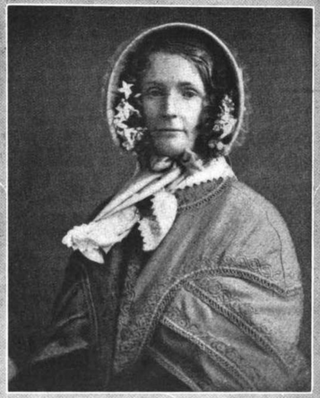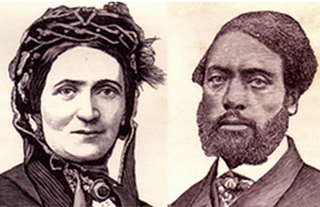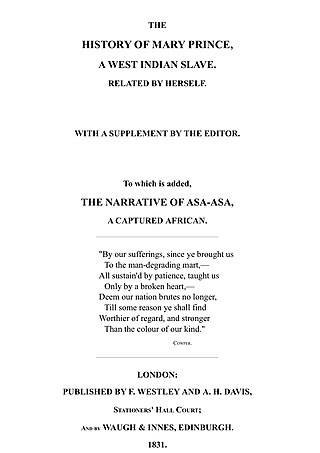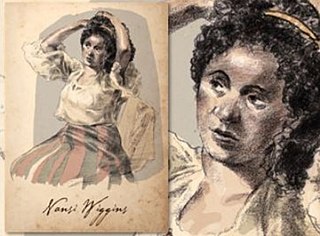The slave narrative is a type of literary genre involving the (written) autobiographical accounts of enslaved Africans, particularly in the Americas. Over six thousand such narratives are estimated to exist; about 150 narratives were published as separate books or pamphlets. In the United States during the Great Depression (1930s), more than 2,300 additional oral histories on life during slavery were collected by writers sponsored and published by the Works Progress Administration, a New Deal program. Most of the 26 audio-recorded interviews are held by the Library of Congress.
Mulatto is a racial classification to refer to people of mixed African and European ancestry. Its use is considered outdated and offensive in several languages, including English and Dutch, whereas in languages such as Spanish and Portuguese is not, and can even be a source of pride. A mulatta is a female mulatto.

Lydia Maria Child was an American abolitionist, women's rights activist, Native American rights activist, novelist, journalist, and opponent of American expansionism.

Harriet Jacobs was an African-American abolitionist and writer whose autobiography, Incidents in the Life of a Slave Girl, published in 1861 under the pseudonym Linda Brent, is now considered an "American classic". Born into slavery in Edenton, North Carolina, she was sexually harassed by her enslaver. When he threatened to sell her children if she did not submit to his desire, she hid in a tiny crawl space under the roof of her grandmother's house, so low she could not stand up in it. After staying there for seven years, she finally managed to escape to the free North, where she was reunited with her children Joseph and Louisa Matilda and her brother John S. Jacobs. She found work as a nanny and got into contact with abolitionist and feminist reformers. Even in New York City, her freedom was in danger until her employer was able to pay off her legal owner.

Maria Weston Chapman was an American abolitionist. She was elected to the executive committee of the American Anti-Slavery Society in 1839 and from 1839 until 1842, she served as editor of the anti-slavery journal The Non-Resistant.

Incidents in the Life of a Slave Girl, written by herself is an autobiography by Harriet Jacobs, a mother and fugitive slave, published in 1861 by L. Maria Child, who edited the book for its author. Jacobs used the pseudonym Linda Brent. The book documents Jacobs's life as a slave and how she gained freedom for herself and for her children. Jacobs contributed to the genre of slave narrative by using the techniques of sentimental novels "to address race and gender issues." She explores the struggles and sexual abuse that female slaves faced as well as their efforts to practice motherhood and protect their children when their children might be sold away.

Sarah Moore Grimké (1792–1873) and Angelina Emily Grimké (1805–1879), known as the Grimké sisters, were the first nationally-known white American female advocates of abolition of slavery and women's rights. They were speakers, writers, and educators.

Clotel; or, The President's Daughter: A Narrative of Slave Life in the United States is an 1853 novel by United States author and playwright William Wells Brown about Clotel and her sister, fictional slave daughters of Thomas Jefferson. Brown, who escaped from slavery in 1834 at the age of 20, published the book in London. He was staying after a lecture tour to evade possible recapture due to the 1850 Fugitive Slave Act. Set in the early nineteenth century, it is considered the first novel published by an African American and is set in the United States. Three additional versions were published through 1867.

Ellen Craft (1826–1891) and William Craft were American abolitionists who were born into slavery in Macon, Georgia. They escaped to the Northern United States in December 1848 by traveling by train and steamboat, arriving in Philadelphia on Christmas Day. Ellen crossed the boundaries of race, class and gender by passing as a white planter with William posing as her personal servant. Their escape was widely publicized, making them among the most famous fugitive slaves in the United States. Abolitionists featured them in public lectures to gain support in the struggle to end the institution.
The tragic mulatto is a stereotypical fictional character that appeared in American literature during the 19th and 20th centuries, starting in 1837. The "tragic mulatto" is a stereotypical mixed-race person, who is assumed to be depressed, or even suicidal, because they fail to completely fit in the "white world" or the "black world". As such, the "tragic mulatto" is depicted as the victim of the society that is divided by race, where there is no place for one who is neither completely "black" nor "white".
Plaçage was a recognized extralegal system in French and Spanish slave colonies of North America by which ethnic European men entered into civil unions with non-Europeans of African, Native American and mixed-race descent. The term comes from the French placer meaning "to place with". The women were not legally recognized as wives but were known as placées; their relationships were recognized among the free people of color as mariages de la main gauche or left-handed marriages. They became institutionalized with contracts or negotiations that settled property on the woman and her children and, in some cases, gave them freedom if they were enslaved. The system flourished throughout the French and Spanish colonial periods, reaching its zenith during the latter, between 1769 and 1803.

Partus sequitur ventrem was a legal doctrine passed in colonial Virginia in 1662 and other English crown colonies in the Americas which defined the legal status of children born there; the doctrine mandated that children of slave mothers would inherit the legal status of their mothers. As such, children of enslaved women would be born into slavery. The legal doctrine of partus sequitur ventrem was derived from Roman civil law, specifically the portions concerning slavery and personal property (chattels), as well as the common law of personal property.

The Octoroon is a play by Dion Boucicault that opened in 1859 at The Winter Garden Theatre, New York City. Extremely popular, the play was kept running continuously for years by seven road companies. Among antebellum melodramas, it was considered second in popularity only to Uncle Tom's Cabin (1852).

Mary Prince was the first black woman to publish an autobiography of her experience as a slave, born in the colony of Bermuda to an enslaved family of African descent. After being sold a number of times and being moved around the Caribbean, she was brought to England as a servant in 1828, and later left her enslaver.

The institution of slavery in North America existed from the earliest years of the colonial history of the United States until 1865 when the Thirteenth Amendment abolished slavery throughout the United States except as punishment for a crime. It was also abolished among the sovereign Indian tribes in Indian Territory by new peace treaties which the US required after the Civil War.

A Sojourn in the City of Amalgamation, in the Year of Our Lord, 19-- is a dystopian novel written by Jerome B. Holgate (1812–93) under the pseudonym of Oliver Bolokitten. It was self-published by the author in New York in February 1835. The novel criticizes abolitionists by describing them as endorsers of "amalgamation", or interracial marriage. The narrator encounters a future city, Amalgamation, where white people and black people have intermarried solely for the sake of racial equality, resulting in "moral degeneration, indolence, and political and economic decline." The work is one of the first uses of a satirical novel, speaking against interracial marriage and for black recolonization. The novel is also one of the earliest pieces of dystopian fiction.

George Bradburn was an American politician and Unitarian minister in Massachusetts known for his support for abolitionism and women's rights. He attended the 1840 conference on Anti-Slavery in London where he made a stand against the exclusion of female delegates. In 1843 he was with Frederick Douglass on a lecture tour in Indiana when they were attacked. Lydia Maria Child wrote with regard to his work on anti-slavery that he had " a high place among the tried and true."

The Grandissimes: A Story of Creole Life is a novel by George Washington Cable, published as a book in 1880 by Charles Scribner's Sons after appearing as a serial in Scribner's. The historical romance depicts race and class relations in New Orleans at the start of the 19th century, immediately following the Louisiana Purchase in 1803. The book examines the lives and loves of the extended Grandissime family, which includes members from different races and classes in Creole society. The novel juxtaposes a romanticized version of the French Creole culture with the atrocities committed under the European-American system of slavery in the United States.

Ana Gallum, also referred to as Nansi Wiggins, was a Senegalese woman, who was enslaved in Florida, eventually becoming a slave owning planter herself.
















